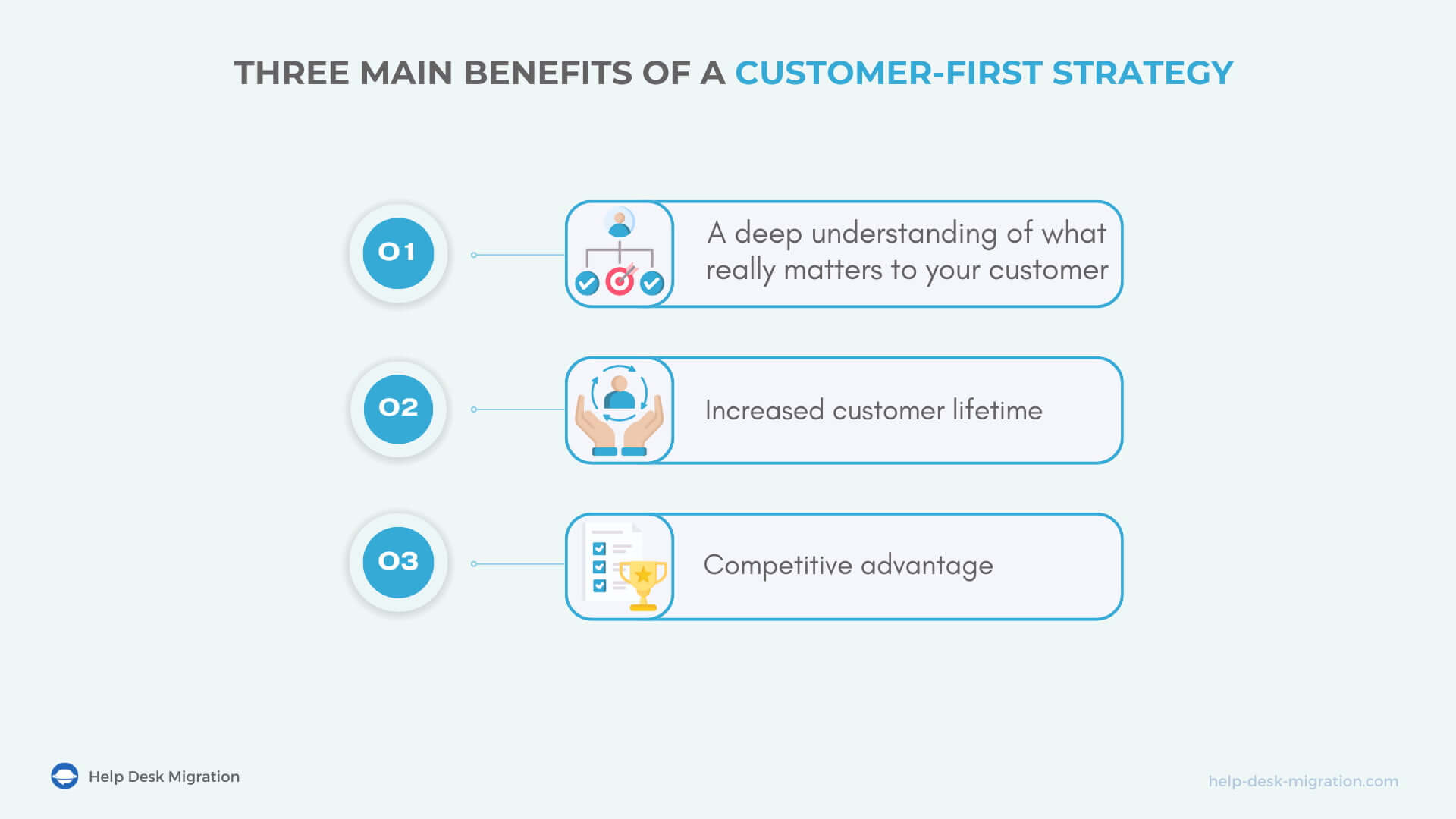A Customer-First Strategy puts your customers at the heart of everything you do. It’s about understanding their needs, exceeding their expectations, and building lasting relationships through great experiences and continuous improvement. Happy customers, stronger loyalty—that’s the goal.
What matters more to customers: the products you offer or their overall experience with your company? It turns out that 80% of customers believe both are equally important.
So why do many companies focus solely on products and services and forget about the customer experience? In this blog post, you’ll learn how to build a customer-first approach in your customer service and make clients stick with your business, no matter how tough the competition is.
Let’s start with the meaning of customer first.
What does a customer-first strategy mean?
Сustomer first is not just a strategy. It’s a culture that shapes planning and empowers everyone in the company to place the customer at the center of all decisions.
Simply put, the customer-first approach shifts the focus from products and services to customer needs and problems. To better understand the concept of customer first, let’s review some of its core statements:
- Value relationships, not just deals. Deals will come as a result of strong relationships with your customers.
- Winning the customer isn’t the end of the customer journey. It’s the beginning.
- Treat each customer like they are the only customer you have.
- Businesses run well when the customers are happy.
With a customer-first mindset, the customer service team's responsibilities go beyond just handling customer requests. Now, it’s about delivering a unique customer experience, increasing customer retention, and directly influencing business success.
Let’s review the main benefits of a customer-first strategy in more detail.
Three main benefits of a customer-first strategy
A customer-centric strategy helps companies build a strong emotional connection with their customers and, as a result, get the following benefits.

A deep understanding of what really matters to your customer
Products do not come out of nowhere; they have to solve real problems for real people. Since customer service teams have a direct connection with clients, a customer-first strategy will help the team get a deep understanding of customer pain points, motivations, and goals. Then, these insights can be shared with other teams to improve products and customer experience metrics.
Increased customer lifetime
The growth of a company largely depends on how well you retain your customers. Nearly three-quarters of your sales will come from existing customers. When you understand your clients and practice a client-first approach, they are more likely to stay with you, make repetitive purchases, and recommend your company to others.
Competitive advantage
Exceptional customer service can become your company’s selling point. If two companies offer a similar product, customers will more likely choose the one that treats them with respect and attention. Building your business goals around customer needs gives you a real advantage over the competition.
But how can you truly make customers the focal point of your business plan? Let’s explore that below.
9 ways to put the customer at the center of your customer service
Now, let’s look at the actual steps the customer service team can take to turn a customer-first approach into an actionable plan.
Know what your customers value in communication
Everyone perceives good customer service in different ways, and there is no one-size-fits-all definition of this term.
Find out what good service means for different segments of your customers and what exactly they value in communication. For example, some customers prioritize calls over text messages, while others find calls annoying and never answer them. Find out what communication channels they use and how they want you to contact them.
Survey your customers
One of the best ways to find out what customers value in communication is to survey them regularly. Surveys display your dedication to a customer and help you gain insights into customer needs and their overall experience with your product or service. Such communication with customers shows that their opinions matter and that they can impact the product as well.
Respond quickly
The slower the ticket resolution time, the lower the customer satisfaction. HubSpot reveals that 67% of customers expect their requests to be resolved in less than three hours.
However, if you can’t answer their question right away, don’t ignore it. Let your customers know that you have received their request and set expectations on when they will receive an answer.
Provide a smooth omnichannel customer experience
Customers are reaching out to support teams in a number of ways, from emails to online chats and social media. The worst thing you can do is make customers repeat themselves and ask them the same questions. Integrate all the offline and online customer data into a single source of truth (e.g., CRM system) so your customers can easily switch between the channels without losing the context of the conversation.
Personalize your customer experience
Personalization goes beyond just using your customers’ names and sending them birthday wishes. It’s all about taking into account customers' past interactions with your company and their data to give them personalized solutions.
Be proactive
Proactive customer service is all about anticipating the customer's needs and reaching out to them before the issue arises.
For example, you can create a short video that explains how to use a customer dashboard and send it to the customers together with the sign-in link. Or you can warn the customer if there is a delay in product or service delivery before they reach out to you with a complaint. Make the first move and show that you put the customer first.
Deliver a consistent customer experience
Create solid principles that will help the customer service team deal with unique situations in a way that reflects the company culture. These may include scripts to handle different customer inquiries, a tone of voice guide, or a set of customer service core principles.
Invest in customer self-service
In 2023, companies started to recognize a new type of customer — the one who likes to handle issues on their own. ‘DIY’ customers do not want to wait for responses, explain their issues to agents, or call a service rep. Instead, they prefer to use online resources, such as FAQs or knowledge bases, to address their problem independently.
Invest in customer self-service to help customers quickly serve themselves and decrease the number of incoming tickets.
Train your team
If you don’t align your team with a customer-first strategy, it will be empty words. A strategy is a set of actions, and the team makes it real.
One of the ways to train your team is to provide in-house employee training. You can organize regular customer support team panels to simulate different scenarios and discuss how to handle them, practice call reviews, and run various service training exercises.
| Way | Details |
|
Know What Customers Value |
Understand what different customer segments value in communication. Identify preferred channels and tailor outreach accordingly. |
|
Survey Customers |
Regular surveys provide insights into customer preferences, show dedication, and demonstrate that their opinions matter. |
|
Respond Quickly |
Aim for quick resolution times (67% expect <3 hours). If delays occur, acknowledge requests promptly and set response expectations. |
|
Integrate customer data into a single source to ensure smooth interactions across multiple channels without repetitive questions. |
|
|
Personalize Customer Experience |
Use customer data and past interactions to offer tailored solutions, going beyond basic personalization like names or birthdays. |
|
Be Proactive |
Anticipate customer needs by offering helpful resources or addressing potential issues before they arise (e.g., proactive communication about delays). |
|
Deliver Consistent Experiences |
Develop clear principles (e.g., scripts, tone of voice guides, service principles) to ensure responses align with company culture. |
|
Invest in Self-Service |
Provide resources like FAQs and knowledge bases for 'DIY' customers who prefer solving issues independently, reducing incoming ticket volume. |
|
Train Your Team |
Align your team with a customer-first strategy through regular training, scenario simulations, call reviews, and service exercises to ensure consistent quality. |
Challenges companies may face when becoming customer-first
You can’t become customer-first overnight, as implementing this strategy requires time and effort. Let’s review some common challenges you may face and how to overcome them.
Diverse customer expectations
Customer demands are different, and so it can be challenging to serve everyone without spreading yourself too thin. To deliver positive customer experiences, divide your customers into groups based on their needs, business goals (if they are B2B customers), preferences, and behavior.
For example, you can segment your customer base according to the value they bring to your business and put more effort into serving customers, which brings in more revenue. Don’t forget the 20/80 Pareto rule: 80% of company revenue comes from 20% of repeat customers. Focus on this group of clients to increase client retention and grow company profit as a result.
Disconnected teams
A team is the foundation of all business processes, and you can’t grow if your team members are disconnected.
Ineffective communication leads to gaps in customer experience where customer service, sales, and marketing operate separately. Meanwhile, the customer-first approach works only if it’s practiced during the whole customer journey. This can only be achieved if the entire team works as a unit. How can marketing teams create a customer-first marketing strategy if they don’t collaborate with service teams?
So, it’s key to encourage collaboration between the teams and create meetings where they can share their insights about customers. Also, ensure that feedback from customers is shared across all relevant teams. Such an approach will unite everyone around putting customers first and will help maintain a customer-centric culture.
Gaps in customer data
You need to integrate customer data with your service tools to keep connected with your customers. According to the HubSpot 2024 State of Service Report, over three-quarters of service leaders suffer from gaps in the data on their customers’ experience. Just 24% were confident that they were fully informed on all funnels.
One solution to avoid poor customer experience because of data silos is to use a robust data analytics software tool that will parse customer data from different sources and give service reps full visibility of the client journey.
Examples of businesses that prioritize a customer-first approach
Now, let’s get some inspiration from successful companies that put the customer first and are known for their customer-obsessed culture.
HubSpot — a provider of software solutions for marketing, sales, and customer service
At the core of HubSpot's customer-centric mindset lies the flywheel model, which unites the entire organization around delivering a remarkable customer experience.
The standard funnel focuses on acquiring the customer but doesn’t view customers as a driving force that helps the company grow. In the flywheel model, however, winning the customer is just the beginning of the customer journey.
According to this approach, the entire team (including marketing, sales, and support departments) is focused on engaging and delighting customers. Here is the list of the main HubSpot principles according to the flywheel methodology:
- Revenue and growth are the outcome of happy customers.
- Make sure every decision is focused on the value it brings to your customers.
- To grow, it’s essential to remember that your customers are people, not just numbers in your CRM. Treat them with empathy and connect with them in the way they prefer.
Buffer — a social media toolkit for small businesses
Exceptional customer experience has always been part of the Buffer DNA, where the customer comes first. The customer service at Buffer is inspired by hospitality organizations. With over 75,000 customer requests per year, the Buffer team strives to deliver the intimate and personalized experience you can get with a small business.
To deliver this high level of support, Buffer approaches its target customers with awareness, clarity, and empowerment where awareness is “I understand you,” clarity is “I make sure you understand me,” and empowerment is “I can help you.” To uphold this framework, the company’s service reps stick to the following principles:
- Treat each customer conversation with curiosity. Among other things, pay attention to the emotions they reach out to you with.
- Look for opportunities to create a personal bond during each conversation. This could involve sharing a relevant story or anecdote that resonates with the customer's situation.
- Go beyond traditional support roles. Aim to be experts in Buffer’s products, demonstrating how customers can maximize their use of these tools.
- Address broader needs. If a customer’s request extends beyond Buffer’s offerings, explore ways to assist them.
Help Desk Migration — your partner in seamless data transfers
At Help Desk Migration, our mission is simple: make data migration stress-free, precise, and effortless. By blending powerful automation with a human touch, we tailor every migration to meet your unique business needs—because no two journeys are the same.
Unlike traditional tools that just move data, we see migration as an opportunity to enhance your service processes and empower your support team to work smarter, not harder.
Here’s how we do it:
- Flawless execution, flawless service: Accurate, seamless data migration is the backbone of uninterrupted support and customer trust.
- Every decision adds value: From smart field mapping to customized processes, we fine-tune every step to elevate your service outcomes.
- Built for your business: Your workflows, your rules. We tailor migrations to fit the nuances of your team and goals.
We don’t just move data—we redefine what migration means for your business.
- Care in every interaction: We get it—data migration can be daunting. That’s why we provide reassurance and clarity at every step.
- Expertise you can trust: Actionable advice and insights ensure you get the most out of your migration.
- Going the extra mile: Custom needs? Uncommon challenges? We’re here to explore creative solutions that fit your business.
- A bigger-picture mindset: Even when your request extends beyond migration, we’ll help you find the right path forward.
With Help Desk Migration, it’s not just about moving data—it’s about building a seamless foundation for your business to thrive. Let’s make it happen.
Conclusion
Customers are becoming more demanding, and if companies don’t treat them with respect, they will switch to another brand. The customer-first approach is all about prioritizing customer needs in every interaction with your company. Investing in a customer-first culture pays off, as customers are inclined to stay with the companies that appreciate them.



